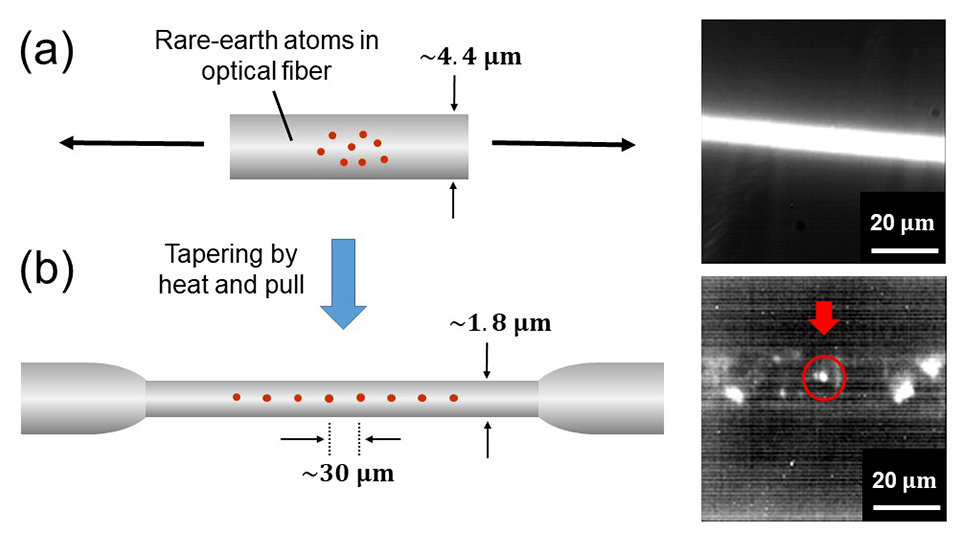The capacity of quantum-based systems is quick in computing and stronger in encryption for computation and communication systems.
 (a) Schematic diagram and microscopic observation of an optical fiber doped with rare-earth atoms. The fluorescence from the entire optical fiber can be seen. (b) Schematic diagram and microscopic observation of the optical fiber after heat and pull processing. Fluorescence from a single rare-earth atom isolated in the optical fiber can be seen. Image Credit: Kaoru Sanaka from TUS, Japan
(a) Schematic diagram and microscopic observation of an optical fiber doped with rare-earth atoms. The fluorescence from the entire optical fiber can be seen. (b) Schematic diagram and microscopic observation of the optical fiber after heat and pull processing. Fluorescence from a single rare-earth atom isolated in the optical fiber can be seen. Image Credit: Kaoru Sanaka from TUS, Japan
These systems can be built on fiber networks connecting interconnected nodes consisting of qubits and single-photon generators, creating entangled photon pairs.
Rare-earth (RE) atoms and ions within solid-state materials hold significant promise as single-photon emitters. These materials are well-suited for integration into fiber networks, emitting photons across a wide spectrum of wavelengths.
Optical fibers enriched with these RE elements could serve diverse purposes, including free-space telecommunication, fiber-based telecommunications, quantum random number generation, and high-resolution image analysis. Nevertheless, up to this point, single-photon light sources have been created utilizing RE-doped crystalline materials at cryogenic temperatures, thereby constraining the practical utilization of quantum networks based on them.
In a study published in the journal Physical Review Applied on October 16, 2023, a team of researchers from Japan, led by Associate Professor Kaoru Sanaka from Tokyo University of Science (TUS), has effectively developed a single-photon light source consisting of doped ytterbium ions (Yb3+) in an amorphous silica optical fiber at room temperature.
Associate Professor Mark Sadgrove and Mr Kaito Shimizu from TUS, and Professor Kae Nemoto from the Okinawa Institute of Science and Technology Graduate University are also involved in this research.
This developed single-photon light source eradicates the need for costly cooling systems, which makes it possible to make quantum networks more cost-effective and accessible.
Single-photon light sources are devices that control the statistical properties of photons, which represent the smallest energy units of light. In this study, we have developed a single-photon light source using an optical fiber material doped with optically active RE elements. Our experiments also reveal that such a source can be generated directly from an optical fiber at room temperature.
Dr. Kaoru Sanaka, Department of Physics, Tokyo University of Science
Ytterbium is a suitable candidate for doping the fiber as it is an RE element with beneficial optical and electronic properties. Ytterbium has a simple energy-level structure with a long fluorescence lifetime of around one millisecond in its excited state.
To produce the ytterbium-doped optical fiber, the researchers employed a heat-and-pull technique, in which they tapered a commercially available ytterbium-doped fiber. This process involves heating a segment of the fiber and then applying tension to steadily reduce its diameter.
In the tapered fiber, individual RE atoms emit photons upon laser excitation. The spacing between these RE atoms plays a pivotal role in shaping the optical characteristics of the fiber. For instance, when the average gap between the individual RE atoms exceeds the optical diffraction limit, determined by the wavelength of the emitted photons, the emitted light from these atoms appears as if it originates from clusters rather than distinct individual sources.
To validate the nature of these emitted photons, the researchers utilized an analytical technique called autocorrelation, which assesses the similarity between a signal and its delayed version. By subjecting the emitted photon pattern to autocorrelation analysis, the researchers detected non-resonant emissions and obtained additional evidence of photon emission stemming from the single ytterbium ion within the doped fiber.
Although there is potential to further improve the quality and quantity of emitted photons, the optical fiber created with ytterbium atoms can be produced without the requirement for costly cooling systems. This breakthrough surmounts a significant obstacle and paves the way for various next-generation quantum information technologies.
We have demonstrated a low-cost single-photon light source with selectable wavelength and without the need for a cooling system. Going ahead, it can enable various next-generation quantum information technologies such as true random number generators, quantum communication, quantum logic operations, and high-resolution image analysis beyond the diffraction limit.
Dr. Kaoru Sanaka, Department of Physics, Tokyo University of Science
Journal Reference
Takezawa, M., et al. (2023). Room-temperature addressing of single rare-earth atoms in optical fiber. Physical Review Applied. doi.org/10.1103/PhysRevApplied.20.044038